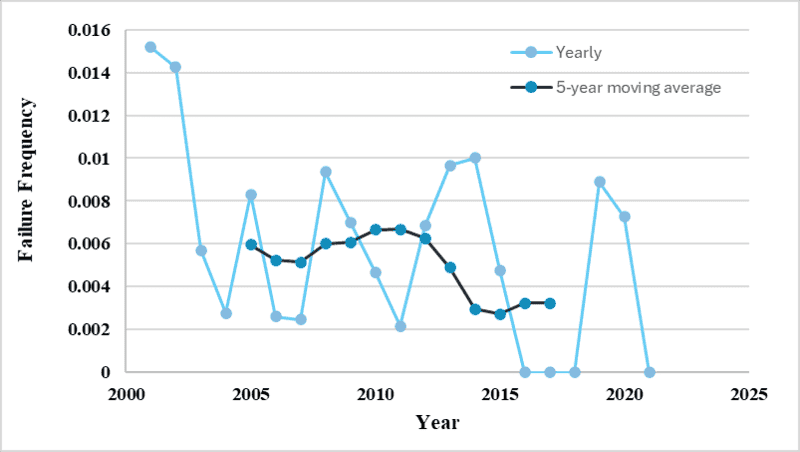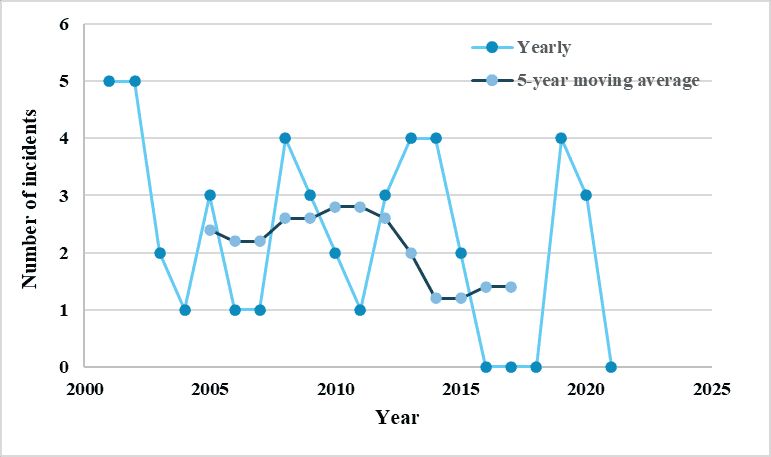Kakashi-01
Chemical
Currently, I am working on a project that necessitates a quantitative risk assessment of crude oil pipelines.
I have collected data on crude oil incidents from the CONCAWE cross country European oil pipeline. The database includes incidents for 3 types of service: crude, refined products, and heated black products (hot oil) over 1971-2021. However, I have used the data from 2001-2002 because as this period includes pipelines that were not previously accounted for in their active pipeline network inventory, making it more representative.
The incidents in the database provide information such as pipe diameter, age of pipe, gross volume and net volume, the facility type (undeground, above ground, and pump station), method of detection, the cause of the spill (mechanical, operational, corrosion, third-party activity, or theft), and contamination in the land (m2) and water (yes/no).
Using the pipeline length and assuming that the age distribution for crude oil pipelines follows the same profile as the total pipeline network (crude, refined products, Hot oil), I calculated the weighted mean age for each year and the pipeline exposure, which is the product of pipeline length and exposed duration. I realized that the crude oil pipeline length remained nearly constant (10,000 km) during the considered period, while the pipeline itself progressively aged over time.
Considering the progressive aging of the pipeline, it is possible that aging could be the contributing factor to the absence of a clear trend in the number of incidents and the failure frequency (calculated as the number of incidents divided by the pipeline exposure) with time?. To remove the impact of random fluctuations, I had to employ a moving average technique.
[URL unfurl="true"]https://res.cloudinary.com/engineering-com/image/upload/v1711805924/tips/plHegLrzXl3zWi-Ne0nC_xR73sPNggX_U0vvdHmwqzmgNPnUBI_shufbg.webp[/url][URL unfurl="true"]https://res.cloudinary.com/engineering-com/image/upload/v1711805933/tips/FgjwDxuaFksUkIntiJWS1npwFf5jMAi3Whs7SAD5wGTe_BC_U4_wlmyth.webp[/url]


I have collected data on crude oil incidents from the CONCAWE cross country European oil pipeline. The database includes incidents for 3 types of service: crude, refined products, and heated black products (hot oil) over 1971-2021. However, I have used the data from 2001-2002 because as this period includes pipelines that were not previously accounted for in their active pipeline network inventory, making it more representative.
The incidents in the database provide information such as pipe diameter, age of pipe, gross volume and net volume, the facility type (undeground, above ground, and pump station), method of detection, the cause of the spill (mechanical, operational, corrosion, third-party activity, or theft), and contamination in the land (m2) and water (yes/no).
Using the pipeline length and assuming that the age distribution for crude oil pipelines follows the same profile as the total pipeline network (crude, refined products, Hot oil), I calculated the weighted mean age for each year and the pipeline exposure, which is the product of pipeline length and exposed duration. I realized that the crude oil pipeline length remained nearly constant (10,000 km) during the considered period, while the pipeline itself progressively aged over time.
Considering the progressive aging of the pipeline, it is possible that aging could be the contributing factor to the absence of a clear trend in the number of incidents and the failure frequency (calculated as the number of incidents divided by the pipeline exposure) with time?. To remove the impact of random fluctuations, I had to employ a moving average technique.
[URL unfurl="true"]https://res.cloudinary.com/engineering-com/image/upload/v1711805924/tips/plHegLrzXl3zWi-Ne0nC_xR73sPNggX_U0vvdHmwqzmgNPnUBI_shufbg.webp[/url][URL unfurl="true"]https://res.cloudinary.com/engineering-com/image/upload/v1711805933/tips/FgjwDxuaFksUkIntiJWS1npwFf5jMAi3Whs7SAD5wGTe_BC_U4_wlmyth.webp[/url]



